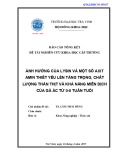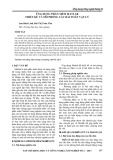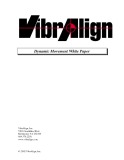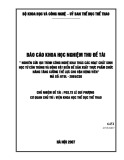
BioMed Central
Page 1 of 11
(page number not for citation purposes)
BMC Psychiatry
Open Access
Research article
Predictors and correlates for weight changes in patients co-treated
with olanzapine and weight mitigating agents; a post-hoc analysis
Virginia L Stauffer*1, Ilya Lipkovich2, Vicki Poole Hoffmann3,
Alexandra N Heinloth4, H Scott McGregor1 and Bruce J Kinon3
Address: 1Neuroscience, Lilly USA, LLC, Indianapolis, IN 46285, USA, 2Statistics, Eli Lilly and Company, IN 46285, USA, 3Neuroscience, Eli Lilly
and Company, IN 46285, USA and 4i3Statprobe, subsidiary of United Health Group, Ann Arbor, MI, USA
Email: Virginia L Stauffer* - Stauffer_Virginia@Lilly.com; Ilya Lipkovich - Lipkovich_Ilya_A@Lilly.com;
Vicki Poole Hoffmann - Hoffmann_Vicki_Poole@Lilly.com; Alexandra N Heinloth - Alexandra.Heinloth@i3Statprobe.com; H
Scott McGregor - Mcgregor_Scott_H@Lilly.com; Bruce J Kinon - Kinon_Bruce@Lilly.com
* Corresponding author
Abstract
Background: This study focuses on exploring the relationship between changes in appetite or
eating behaviors and subsequent weight change for adult patients with schizophrenia or bipolar
disorder treated with olanzapine and adjunctive potential weight mitigating pharmacotherapy. The
aim is not to compare different weight mitigating agents, but to evaluate patients' characteristics
and changes in their eating behaviors during treatment. Identification of patient subgroups with
different degrees of susceptibility to the effect of weight mitigating agents during olanzapine
treatment may aid clinicians in treatment decisions.
Methods: Data were obtained from 3 randomized, double-blind, placebo-controlled, 16-week
clinical trials. Included were 158 patients with schizophrenia or bipolar disorder and a body mass
index (BMI) ≥ 25 kg/m2 who had received olanzapine treatment in combination with nizatidine (n
= 68), sibutramine (n = 42), or amantadine (n = 48). Individual patients were analyzed for
categorical weight loss ≥ 2 kg and weight gain ≥ 1 kg. Variables that were evaluated as potential
predictors of weight outcomes included baseline patient characteristics, factors of the Eating
Inventory, individual items of the Eating Behavior Assessment, and the Visual Analog Scale.
Results: Predictors/correlates of weight loss ≥ 2 kg included: high baseline BMI, low baseline
interest in food, and a decrease from baseline to endpoint in appetite, hunger, or cravings for
carbohydrates. Reduced cognitive restraint, increase in hunger, and increased overeating were
associated with a higher probability of weight gain ≥ 1 kg.
Conclusion: The association between weight gain and lack of cognitive restraint in the presence
of increased appetite suggests potential benefit of psychoeducational counseling in conjunction with
adjunctive pharmacotherapeutic agents in limiting weight gain during antipsychotic drug therapy.
Trial Registration: This analysis was not a clinical trial and did not involve any medical
intervention.
Published: 28 March 2009
BMC Psychiatry 2009, 9:12 doi:10.1186/1471-244X-9-12
Received: 20 August 2008
Accepted: 28 March 2009
This article is available from: http://www.biomedcentral.com/1471-244X/9/12
© 2009 Stauffer et al; licensee BioMed Central Ltd.
This is an Open Access article distributed under the terms of the Creative Commons Attribution License (http://creativecommons.org/licenses/by/2.0),
which permits unrestricted use, distribution, and reproduction in any medium, provided the original work is properly cited.

BMC Psychiatry 2009, 9:12 http://www.biomedcentral.com/1471-244X/9/12
Page 2 of 11
(page number not for citation purposes)
Background
In adult patients with serious and persistent mental ill-
nesses such as bipolar disorder or schizophrenia, obesity
is a common comorbidity. [1] Many antipsychotic medi-
cations used to treat these diseases are associated with an
increased risk of weight gain. A meta-analysis by Allison
and colleagues showed a significantly greater incidence of
weight gain in patients treated with clozapine or olanzap-
ine compared with patients treated with other atypical
antipsychotics. [2] Since 1996, the United States (US) pre-
scribing information for olanzapine has advised clinicians
of the potential for significant weight gain in more than 1/
4 of patients during short-term therapy and in more than
1/2 of patients who receive long-term olanzapine therapy.
The current prescribing information for olanzapine warns
clinicians of the potential for short- and long-term weight
gain during treatment. [3] Treatment-emergent weight
gain may influence both the physical health of the patient
and treatment continuation. Considering the high obesity
rates in the US general population (32.9%) [4] and in
patients with schizophrenia (42%), [5] the potential risk
of weight gain needs to be evaluated carefully.
Recently, the Clinical Antipsychotic Trials of Intervention
Effectiveness (CATIE) study evaluated the overall treat-
ment effectiveness of olanzapine, perphenazine, quetiap-
ine, risperidone, and ziprasidone. In this study, patients
treated with olanzapine showed the greatest treatment
effectiveness as determined by measuring the length of
time patients remained on their prescribed medication.
Patients treated with olanzapine remained on their medi-
cation statistically significantly longer compared to
patients treated with quetiapine or risperidone, but not
compared to patients treated with perphenazine or
ziprasidone. [6] However, olanzapine-treated patients
gained significantly more weight than patients in the
other treatment groups (p < .001), and significantly more
patients treated with olanzapine reported potentially clin-
ically significant weight gain ≥ 7% increase from baseline
weight (p < .001) and discontinued treatment due to
weight gain or changes in metabolic parameters (p <
.001). [6]
In light of these data, clinicians are searching for effective
strategies to help manage potential weight gain in this
patient population. While one option is to switch to
another antipsychotic medication that may have a more
favorable weight gain profile, this does not always reverse
the weight gain the patient may have already experienced.
[7] Behavioral therapy and pharmacologic treatments
have been studied as alternatives to switching antipsy-
chotic medications in order to potentially limit or reverse
weight gain during treatment with olanzapine. Recently,
Ganguli published a comprehensive review summarizing
behavioral therapy to induce weight loss in patients with
schizophrenia. [8] This review showed that non-pharma-
cologic interventions were successful in controlling
weight in some patients, and it concluded that all weight
maintenance efforts should include behavioral interven-
tions, dietary advice, and exercise. In addition, the
Cochrane Group recently conducted a comprehensive
review critically evaluating both non-pharmacologic and
pharmacologic randomized controlled trials (RCTs) of
adjunctive agents hypothesized to prevent weight gain or
to reduce weight in patients with schizophrenia who were
receiving antipsychotic treatment. Within the group of
RCTs that were included in this review, studies using cog-
nitive/behavioral therapy showed the best efficacy in
weight prevention (weighted mean difference [WMD]: -
3.38 kg) and, to a lesser extent, in weight reduction
(WMD: -1.69 kg). Pharmacological intervention studies
resulted in a more modest prevention of weight gain
(WMD: -1.16 kg). They concluded that modest weight loss
can be achieved in patients with schizophrenia by phar-
macological and non-pharmacological interventions, but
this conclusion is limited by the small number of studies
available and the substantial heterogeneity across studies.
[9]
A comprehensive review of weight mitigating agents and
their use during treatment with antipsychotics has been
published recently by Baptista and colleagues. [10]
This study focuses on pharmacological interventions and
their ability to prevent weight gain or to induce weight
loss when combined with olanzapine treatment. The aim
is neither to extract predictors for weight change during
olanzapine monotherapy nor to compare different weight
mitigating agents, but to evaluate patients' characteristics
and changes in their eating behaviors during treatment
with olanzapine and weight mitigating agents in over-
weight patients. These predictors may be useful in identi-
fying subgroups of patients who may be susceptible to the
effect of weight mitigating agents during olanzapine treat-
ment.
Previous studies of the effect of weight mitigating agents
focused on evaluating treatment difference in weight
changes, which were often statistically non-significant
[11,12] and might explain the modest effects seen in the
analysis conducted by the Cochrane Group. [9] In con-
trast, we defined categorical outcomes that constitute clin-
ically significant weight loss and weight gain during
treatment. In our opinion, these categorical analyses pro-
vide information that is clinically more useful than analy-
ses based on mean weight changes. We hypothesized that,
in patients who received weight-mitigating agents during
olanzapine treatment, the presence or absence of cogni-
tive restraint and changes in eating behaviors may both be
indicators of subsequent weight loss or weight gain. To

BMC Psychiatry 2009, 9:12 http://www.biomedcentral.com/1471-244X/9/12
Page 3 of 11
(page number not for citation purposes)
evaluate this hypothesis, and to also identify any relevant
demographic characteristics predictive of the outcome, we
performed post-hoc exploratory analyses of patients who
received olanzapine treatment in combination with 1 of 3
weight-mitigating agents (nizatidine, sibutramine, or
amantadine) in 3 Eli Lilly and Company-sponsored, pla-
cebo-controlled, weight-mitigation studies. These studies
were selected because the complete datasets allowed the
examination of potential predictors of weight change and,
therefore, could help identify patients who might or
might not be more susceptible to weight change when
receiving a pharmacologic treatment. We evaluated the
association between appetite, eating behaviors (both at
baseline and post-treatment), and weight change in
patients with schizophrenia or bipolar disorder treated
with olanzapine and an adjunctive pharmacotherapy for
the purpose of identifying potential predictors and corre-
lates for weight changes.
Methods
The analyses presented here utilize data from 3 clinical tri-
als sponsored by Eli Lilly and Company, in adult patients
with a Diagnostic and Statistical Manual of Mental Disor-
ders, Fourth Edition – Text Revision (DSM-IV-TR) diagno-
sis of schizophrenia, schizoaffective disorder,
schizophreniform disorder, or bipolar disorder, that
examined the effects of nizatidine, sibutramine, or aman-
tadine compared to placebo on weight change. Only data
from those 3 trials were included due to the fact that the
authors could not access additional datasets to the extent
necessary. The primary results from each study have been
previously published in peer-reviewed journals [13,14] or
as a clinical trial registry (CTR) summary (http://www.lil
lytrials.com/results/by_product/results_zyprexa.html,
Trial ID: 5102). All study protocols were reviewed and
approved by the appropriate Institutional Review Boards
at each study site before enrolling any patient. Conduct of
the studies was in accordance with the Declaration of Hel-
sinki, the US Federal Drug Administration Code of Fed-
eral Regulations (21 CFR, Part 50), and Good Clinical
Practices. All eligible participants provided written
informed consent before undergoing any study procedure
or receiving any study treatment.
Patients
From the pool of participants who were enrolled in these
3 clinical studies, patients with a baseline BMI ≥ 25 kg/m2
who were receiving treatment with olanzapine and were
randomized to 1 of the adjunctive weight-mitigating
agents or placebo were included in these analyses. In addi-
tion, the 16-week time point was used as a common end-
point. Detailed study design information, including
inclusion and exclusion criteria, can be found in the pri-
mary publications for the nizatidine and amantadine
studies [13,14] and in the CTR summary for the sibu-
tramine study (http://www.lillytrials.com/results/
by_product/results_zyprexa.html, Trial ID: 5102). The
sibutramine and the amantadine studies were designed as
weight-reduction studies (i.e., patients had already experi-
enced a pre-specified threshold of weight gain while
receiving olanzapine treatment), while the nizatidine
study evaluated weight gain prevention after initiation of
olanzapine treatment.
Nizatidine study
In this double-blind, placebo-controlled trial, 175 male
and female patients, 18–65 years of age, were randomly
allocated in a 1:1:1 ratio to receive either open-label olan-
zapine (5–20 mg/day, flexible dosing) combined with
double-blinded nizatidine (150 mg/day or 300 mg/day)
or placebo for 16 weeks. All patients had been diagnosed
with schizophrenia, schizoaffective disorder, or schizo-
phreniform disorder.
Sibutramine study
In this double-blind, placebo-controlled study, 83 male
and female patients, 18–65 years of age, were randomly
allocated to receive either open-label olanzapine (5–20
mg/day, flexible dosing) combined with double-blinded
sibutramine (3 weeks 10 mg/day, fixed dose; 3 weeks dose
adjustment 5–15 mg/day, flexible dose; 10 weeks 5–15
mg/day, fixed dose) or placebo over 16 weeks. Due to
enrollment difficulties, the study was terminated before
the original enrollment goal of 170 patients had been
met. All patients had been diagnosed with schizophrenia,
schizoaffective disorder, schizophreniform disorder, or
bipolar I disorder.
Amantadine study
In this double-blind, placebo-controlled trial, 125 male
and female patients ages 18–65 years, were randomly
assigned to receive either open-label olanzapine (5–20
mg/day, flexible dosing) combined with double-blinded
amantadine (100–300 mg/day, flexible dosing) or pla-
cebo. At the end of the 16-week study period, an 8-week
double-blind extension period followed during which
patients continued to receive open-label olanzapine and
double-blind adjunctive treatment with amantadine. All
patients met the diagnostic criteria for schizophrenia,
schizoaffective or schizophreniform disorder, or bipolar I
disorder.
Definition of Outcomes
For the purpose of these analyses, we defined a priori suc-
cessful outcome as the occurrence of ≥ 2 kg weight loss
and unsuccessful outcome as ≥ 1 kg weight gain. We dis-
criminated between weight loss and weight gain at any
time during the study versus weight loss and weight gain
sustained to the 16-week endpoint or to study discontin-
uation.

BMC Psychiatry 2009, 9:12 http://www.biomedcentral.com/1471-244X/9/12
Page 4 of 11
(page number not for citation purposes)
Eating Behavior Assessment
Outcome measures included 3 eating assessment scales:
the Eating Inventory (EI), [15] the Eating Behavior Assess-
ment (EBA, a Lilly-developed scale, not validated), and
the Visual Analog Scale (VAS). Since the focus of our anal-
yses was on predictors and correlates rather than treat-
ment comparisons, clinically meaningful, non-validated
scales are acceptable explanatory variables for use in a Cox
proportional hazards regression. The EI is a 51-item ques-
tionnaire that measures 3 factors: cognitive restraint of
eating, disinhibition of eating, and susceptibility to hun-
ger. The EBA consists of 9 items and is used to determine
eating behavior during the previous week, rated from 0
("not at all," meaning the patient reported not experienc-
ing the behavior/feeling at all) to 4 ("extremely," meaning
the patient reported exceedingly experiencing the behav-
ior/feeling). The VAS is used to determine eating behavior
during the previous 24 hours and consists of 3 items
(hunger, interest in food, and appetite) rated from 0 ("not
at all," meaning the patient reported not experiencing the
behavior/feeling at all) to 10 ("extremely," meaning the
patient reported exceedingly experiencing the behavior/
feeling). Weight, VAS score, and the EBA were measured at
baseline and at Weeks 1–6, 8, 12, and 16. The EI was
assessed at baseline and at Weeks 4, 8, 12, and 16.
Statistical Analysis
For each study individually, the overall time to weight loss
or weight gain was evaluated with a Kaplan-Meier prod-
uct-limit estimator. To examine associations between
measures of craving, eating factors, and eating behaviors
and subsequent or concurrent weight loss or weight gain,
a proportional hazards Cox regression with study-specific
baseline hazard functions and time-varying covariates was
employed, with disease (psychiatric diagnosis) as one of
the baseline covariates in the model.
Important predictors and correlates were identified using
stepwise variable selection in a Cox proportional hazards
regression model. The original set of variables included
changes from baseline and baseline values for eating
scales, BMI, ethnicity, gender, and age. Only the results for
the final models selected are reported. No subgroup anal-
yses were performed discriminating between patients with
schizophrenia and those with bipolar disorder, as the
resulting sample sizes would be too small to produce
meaningful results. All statistical analyses are reported
with a significance level of p < .05.
Results
Patients
A total of 158 patients met the a priori selection criteria for
the analyses presented here. Table 1 summarizes the
patient characteristics at baseline. The nizatidine study
provided the highest number of patients (n = 68), fol-
lowed by the amantadine (n = 48) and the sibutramine (n
= 42) studies.
Eating Inventory and EBA
To better understand the relationships among the differ-
ent measures of eating behaviors and attitudes, we com-
puted pairwise correlations between the 3 factors of the EI
Table 1: Patient Characteristics at Baseline
Nizatidine
Study
(n = 68)
Sibutramine Study
(n = 42)
Amantadine Study
(n = 48)
Total
(N = 158)
Age, years; mean (SD) 43.5 (10.2) 38.7 (11.6) 40.6 (12.0) 41.3 (11.3)
Weight, kg; mean (SD) 85.1 (12.2) 99.8 (19.7) 95.1 (18.9) 92.1 (17.7)
BMI, kg/m2; mean (SD) 30.1 (3.8) 35.0 (5.7) 32.3 (5.4) 32.1 (5.2)
Age at disease onset, years; mean (SD) 25.5 (7.5) 23.6 (9.8) 24.6 (10.6) 24.7 (9.1)
BPRS; mean (SD) 21.0 (14.1)a8.3 (6.8) 11.6 (8.3) 14.6 (12.1)
Caucasian race, % 67.6 78.6 81.3 74.7
Gender, % males 60.3 35.7 47.9 50.0
EBA Total; mean (SD) 11.4 (4.8)b19.2 (6.2) 19.7 (7.9) 16.0 (7.4)
VAS (hunger); mean (SD) 4.2 (2.2)c5.7 (2.3) 6.1 (2.3) 5.2 (2.4)
VAS (interest in food); mean (SD) 4.8 (2.7)c5.4 (2.5) 6.4 (2.9) 5.4 (2.8)
VAS (appetite); mean (SD) 4.9 (2.4)c5.9 (2.6) 6.7 (2.6) 5.7 (2.6)
Eating Inventory (cognitive restraint); mean (SD) 7.1 (4.1)b8.1 (3.1) 7.4 (3.9) 7.5 (3.8)
Eating Inventory (disinhibition); mean (SD) 5.0 (3.0)b8.2 (3.8) 7.4 (3.3) 6.6 (3.6)
Eating Inventory (hunger); mean (SD) 5.2 (2.9)b8.4 (3.1) 8.3 (3.3) 7.0 (3.4)
Abbreviations: BMI = body mass index; BPRS = Brief Psychiatric Rating Scale; EBA = Eating Behaviors Assessment: total of 9 items; each item is
rated from 0 (not at all) to 4 (extremely); EI = Eating Inventory; SD = standard deviation; VAS = Visual Analog Scale: measurements are points on a
scale from 0 (not at all) to 10 (extremely).
an = 65
bn = 67
cn = 66

BMC Psychiatry 2009, 9:12 http://www.biomedcentral.com/1471-244X/9/12
Page 5 of 11
(page number not for citation purposes)
as well as correlations between these factors and the items
from EBA. At baseline, the 3 factors of the EI had the fol-
lowing correlations within the pooled data (N = 157; 1
patient had missing data at baseline): r = .222 (p = .0051)
between factor I (Cognitive Restraint) and factor II (Disin-
hibition); r = .0025 (p = .9753) between factor I and factor
III (Hunger); and r = .675 (p < .0001) between factor II
and factor III. Note that if factor I and factor II measured
opposite items as might be assumed in a model in which
patients with more cognitive restraint have less disinhibi-
tion, one would expect a negative correlation between
these factors, whereas our results showed a mild positive
correlation (see Discussion pp.17–18).
Pearson correlations between the 3 factors of the EI with
items from the EBA at baseline are shown in Table 2.
Highly significant correlations were observed for all items
from EBA with factor III (Hunger) and significant to
highly significant correlations for most items from EBA
with factor II (Disinhibition).
Weight Outcomes
Analysis of weight outcomes within the individual studies
revealed that the highest percentage of patients who expe-
rienced successful weight loss at any time (42.9%; 18/42)
was in the sibutramine study, while the highest percentage
of patients who showed successful weight loss sustained
to endpoint (33.3%; 16/48) was in the amantadine study.
The highest percentages of weight gain were observed in
the nizatidine study, with 70.2% (47/67) of patients
showing weight gain at any time and 59.7% (40/67)
whose weight gain was sustained to endpoint (Table 3).
Figure 1 illustrates the time to weight loss (Figure 1a) and
to weight gain (Figure 1b) in the individual study popula-
tions. While Figure 1 summarizes the results, it is not
intended to suggest direct comparisons of the efficacies of
the different weight mitigating agents used in our analy-
ses.
Significant Weight Predictors
We were able to identify five significant predictors for
weight loss in patients treated with olanzapine and 1 of
the 3 weight-mitigating agents; 2 of these were baseline
variables while 3 were time-dependent variables: higher
baseline BMI, less interest in food at baseline, decrease in
appetite, decrease in cravings for carbohydrates, and
decrease in hunger (Table 4). On the other hand, 3 time-
dependent variables were significantly correlated with
weight gain in our patient cohort: decrease in cognitive
restraint, increase in hunger, and increase in overeating
(Table 5).
Discussion
In these post-hoc analyses, we examined the association
between appetite, eating behavior, and weight change for
patients with schizophrenia or bipolar disorder treated
with olanzapine and one of three potential weight miti-
gating agents: nizatidine, sibutramine, or amantadine. We
were able to extract predictors for weight loss and for
weight gain in these patients. Additionally, we analyzed
categorical weight loss and weight gain at any time during
the study, and weight change maintained to endpoint for
the individual study groups. These results varied widely
among the 3 compounds studied. The analyses presented
here did not focus on the phenomenon of weight gain as
a treatment emergent adverse event during treatment with
olanzapine, which has already been very well character-
ized. [2,3,6]
Table 2: Correlations of EI Factors with Items from EBA
Eating Behavior Assessment Items FACTOR I
"Cognitive Restraint"
FACTOR II
"Disinhibition"
FACTOR III
"Hunger"
1. How hungry have you been? 5.5 17.3a28.5c
2. How strong has your appetite been? 3.8 17.2a38.7c
3. Have you craved sweets or other carbohydrates? 2.2 29.2c40.4c
4. Have you craved fatty foods? 5.6 15.9a23.2b
5. When you finished a meal, have you felt full or satisfied? 15.3 -2.5 -21.1b
6. Does it take an excessive amount of food before you feel satisfied? 5.7 23.3b35.3c
7. Have you been thinking about food? 15.4 41.9c41.6c
8. Have you been overeating? 0.3 39.0c43.9c
9. Do you feel your eating is out of control? -11.2 44.3c43.6c
Total score 6.8 41.5c49.2c
Abbreviations: EBA = Eating Behaviors Assessment; EI = Eating Inventory.
Values in %
Pearson correlations × 100 adjusted for study effect and baseline BMI
n = 150
ap < .05
bp < .01
cp < .001


























